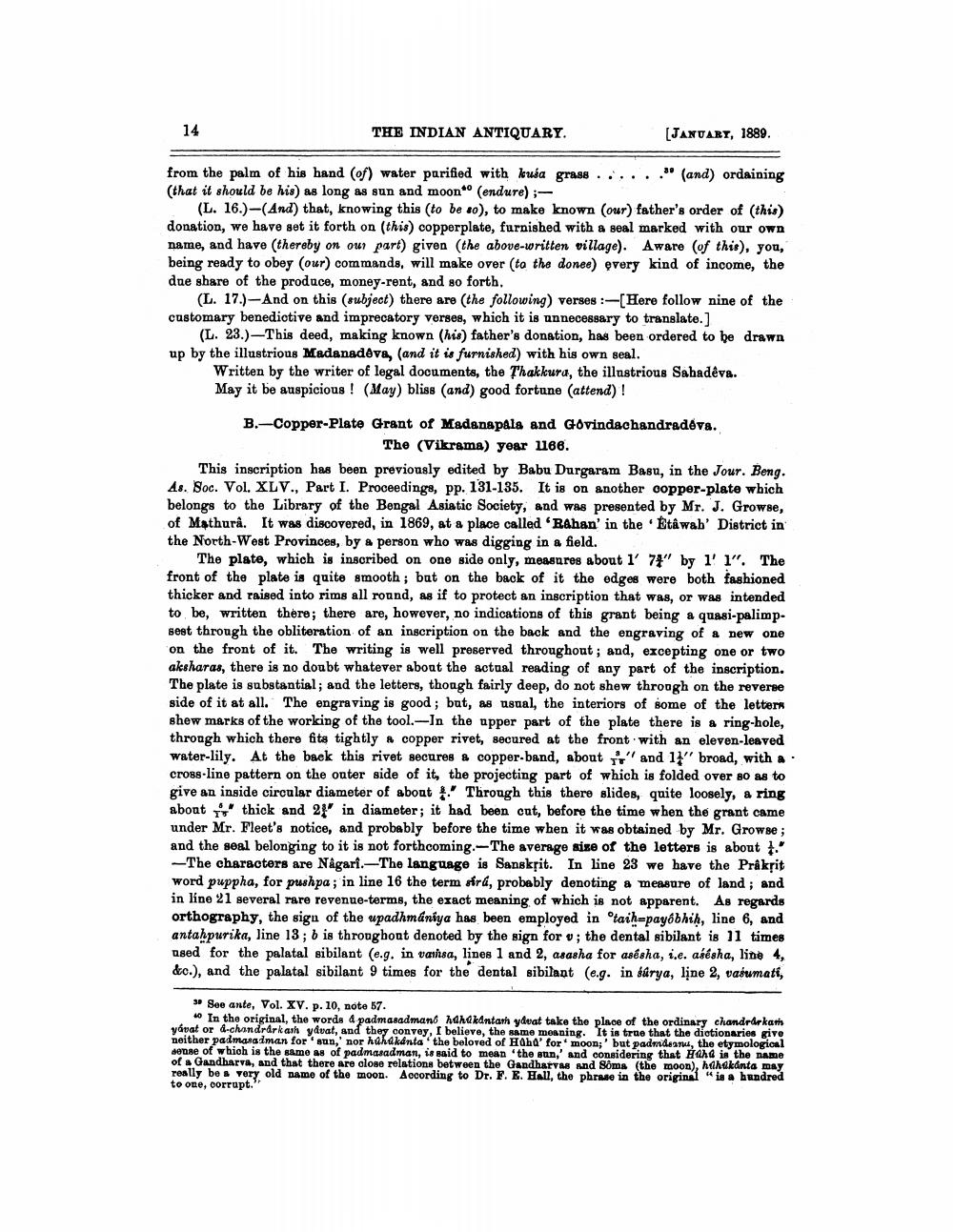________________
14
THE INDIAN ANTIQUARY.
(JANUARY, 1889.
from the palm of his hand (of) water purified with kusa grass ......" (and) ordaining (that it should be his) as long as sun and moon" (endure) ;
(L. 16.)-(And) that, knowing this to be so), to make known (our) father's order of (this) donation, we have set it forth on (this) copperplate, furnished with a seal marked with our own name, and have (thereby on our part) given the above-written village). Aware of this), you, being ready to obey (our) commands, will make over to the donee) every kind of income, the due share of the produce, money-rent, and so forth.
(L. 17.)-And on this subject) there are the following) verses :-[Here follow nine of the customary benedictive and imprecatory verses, which it is unnecessary to translate.]
(L. 23.)-This deed, making known (his father's donation, has been ordered to be drawn up by the illustrious Madanadeva, (and it is furnished) with his own seal.
Written by the writer of legal documents, the Thakkura, the illustrious Sabadêva. May it be auspicious! (May) bliss (and) good fortune (attend)!
B.-Copper-Plate Grant of Madanapala and Govindachandradova.
The (Vikrama) year 1166. This inscription has been previously edited by Babu Durgaram Basu, in the Jour. Beng. As. Soc. Vol. XLV., Part I. Proceedings, pp. 131-135. It is on another oopper-plate which belongs to the Library of the Bengal Asiatic Society, and was presented by Mr. J. Growse, of Mathura. It was discovered, in 1869, at a place called 'Rahan' in the Etawab' District in the North-West Provinces, by a person who was digging in a field.
The plate, which is inscribed on one side only, measures about 1' 74" by 1' 1". The front of the plate is quite smooth; but on the back of it the edges were both fashioned thicker and raised into rims all round, as if to protect an inscription that was, or was intended to be, written there, there are, however, no indications of this grant being a quasi-palimpsest through the obliteration of an inscription on the back and the engraving of a new one on the front of it. The writing is well preserved throughout; and, excepting one or two aksharas, there is no doubt whatever about the actual reading of any part of the inscription. The plate is substantial; and the letters, though fairly deep, do not shew through on the reverse side of it at all. The engraving is good; but, as usual, the interiors of some of the letters shew marks of the working of the tool.- In the upper part of the plate there is a ring-hole, through which there fits tightly a copper rivet, secured at the front with an eleven-leaved water-lily. At the back this rivet secures & copper-band, about it and 1 broad, with a. cross-line pattern on the outer side of it, the projecting part of which is folded over 80 as to give an inside circular diameter of about . Through this there slides, quite loosely, a ring about " thick and 21" in diameter; it had been cut, before the time when the grant came under Mr. Fleet's notice, and probably before the time when it was obtained by Mr. Growse ; and the seal belonging to it is not forthcoming.-The average size of the letters is about 1
-The characters are Nagari.-The language is Sanskpit. In line 23 we have the Praksit word puppha, for pushpa ; in line 16 the term srl, probably denoting a measure of land ; and in line 21 several rare revenue-terms, the exact meaning of which is not apparent. As regards orthography, the sign of the upadhmaniya has been employed in otaih-payőbhih, line 6, and antahpurika, line 13; b is throughout denoted by the sign for v; the dental sibilant is 11 times used for the palatal sibilant (e.g. in varisa, lines 1 and 2, asasha for asésha, i.e. akésha, line 4, &c.), and the palatal sibilant 9 times for the dental sibilant (e.g. in fárya, lịne 2, vasumatí,
» Soe ante, Vol. XV. p. 10, note 57.
0 In the original, the words & padmasadmand hdhdkdntarh yavat take the place of the ordinary chandrarkan vávat or 4-chandrarkas yavat, and they convey, I believe, the same meaning. It is true that the dictionaries give neither padmanadman forsun, nor hahakanta the beloved of Hohd' for moon;' but padmdaarui, the etymological sense of which is the same as of padmaradman, is said to mean the sun,' and considering that Hand is the name of Gandharva, and that there are close relations between the Gandharvas and Sôma (the moon), hahakanta may really be very old name of the moon. According to Dr. F. E. Hall, the phrme in the original is a hundred to one, corrupt.




